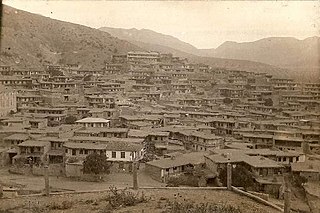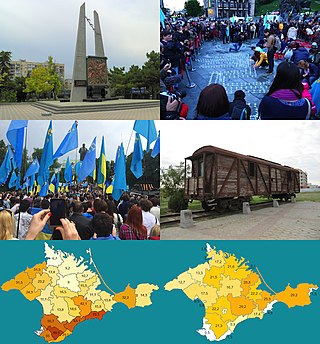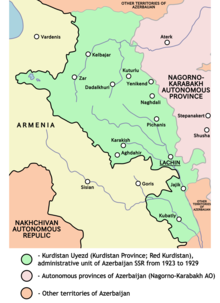
From 1930 to 1952, the government of the Soviet Union, on the orders of Soviet leader Joseph Stalin under the direction of the NKVD official Lavrentiy Beria, forcibly transferred populations of various groups. These actions may be classified into the following broad categories: deportations of "anti-Soviet" categories of population, deportations of entire nationalities, labor force transfer, and organized migrations in opposite directions to fill ethnically cleansed territories. Dekulakization marked the first time that an entire class was deported, whereas the deportation of Soviet Koreans in 1937 marked the precedent of a specific ethnic deportation of an entire nationality.

During the existence of the Soviet Union, different governments existed within the Crimean Peninsula. From 1921 to 1936, the government in the Crimea was known as the Crimean Autonomous Socialist Soviet Republic and was an Autonomous Soviet Socialist Republic within the Russian Soviet Federative Socialist Republic (SFSR); from 1936 to 1945, the name was slightly altered to the Crimean Autonomous Soviet Socialist Republic.

Caucasus Germans are part of the German minority in Russia and the Soviet Union. They migrated to the Caucasus largely in the first half of the 19th century and settled in the North Caucasus, Georgia, Azerbaijan, Armenia and the region of Kars. In 1941, the majority of them were subject to deportation to Central Asia and Siberia during Joseph Stalin's population transfer in the Soviet Union. After Stalin's death in 1953 and the beginning of the Khrushchev Thaw, the Caucasus Germans were allowed to return, though only few did. Many assimilated and, after 1991, emigrated to Germany. Although the community today is a fraction of what it once was, many German buildings and churches are still extant, with some turned into museums.

Kurdistan Uezd, also known colloquially as Red Kurdistan, was a Soviet administrative unit within the Azerbaijan SSR that existed for six years from 1923 to 1929 and included the districts of Kalbajar, Lachin, Qubadli and part of Jabrayil. It was part of Azerbaijan SSR, with the administrative center being in Lachin. It was briefly succeeded by the Kurdistan Okrug from 30 May to 23 July 1930.

After it was established on most of the territory of the Russian Empire, the Soviet Union remained the world's largest country until it collapsed in 1991. It covered a large part of Eastern Europe while also spanning the entirety of the Caucasus, Central Asia, and Northern Asia. During this time, Islam was the country's second-largest religion; 90% of Muslims in the Soviet Union were adherents of Sunni Islam, with only around 10% adhering to Shia Islam. Excluding the Azerbaijan SSR, which had a Shia-majority population, all of the Muslim-majority Union Republics had Sunni-majority populations. In total, six Union Republics had Muslim-majority populations: the Azerbaijan SSR, the Kazakh SSR, the Kyrgyz SSR, the Tajik SSR, the Turkmen SSR, and the Uzbek SSR. There was also a large Muslim population across Volga–Ural and in the northern Caucasian regions of the Russian SFSR. Across Siberia, Muslims accounted for a significant proportion of the population, predominantly through the presence of Tatars. Many autonomous republics like the Karakalpak ASSR, the Chechen-Ingush ASSR, the Bashkir ASSR and others also had Muslim majorities.

The deportation of the Crimean Tatars or the Sürgünlik ('exile') was the ethnic cleansing and the cultural genocide of at least 191,044 Crimean Tatars which was carried out by Soviet Union authorities from 18 to 20 May 1944, supervised by Lavrentiy Beria, chief of Soviet state security and the secret police, and ordered by the Soviet leader Joseph Stalin. Within those three days, the NKVD used cattle trains to deport the Crimean Tatars, mostly women, children, and the elderly, even Communist Party members and Red Army members, to the Uzbek SSR, several thousand kilometres away. They constituted one of the several ethnicities which were subjected to Stalin's policy of population transfer in the Soviet Union.

Mir Jafar Abbas oghluBaghirov was the communist leader of the Azerbaijan SSR from 1933 to 1953, under the Soviet leadership of Joseph Stalin.

The Kurds in Armenia, also referred to as the Kurds of Rewan, form a major part of the historically significant Kurdish population in the post-Soviet space, and live mainly in the western parts of Armenia.

Azerbaijanis in Armenia numbered 29 people according to the 2001 census of Armenia. Although they have previously been the biggest minority in the country according to 1831–1989 censuses, they are virtually non-existent since 1988–1991 when most fled or were forced out of the country as a result of the tensions of the First Nagorno-Karabakh War to neighboring Azerbaijan. The UNHCR estimates that the current population of Azerbaijanis in Armenia to be somewhere between 30 and a few hundred people, with most of them living in rural areas as members of mixed couples, as well as elderly or sick. Most of them are reported to have changed their names to maintain a low profile to avoid discrimination.

The Kurds in Azerbaijan form a part of the historically significant Kurdish population in the post-Soviet space. Kurds established a presence in the Caucasus with the establishment of the Kurdish Shaddadid dynasty in the 10th and 11th centuries. Some Kurdish tribes were recorded in Karabakh by the end of the sixteenth century. However, virtually the entire contemporary Kurdish population in the modern Azerbaijan descends from migrants from 19th-century Qajar Iran.
Mass deportation of Azerbaijanis from Armenia took place several times throughout the 20th century, and sometimes some of them have been described by some authors as acts of forced resettlement and ethnic cleansing.
Ruben Gukasovich Rubenov, also known as Ruben Mkrtichyan, was a Bolshevik revolutionary and Soviet politician who served as the 6th First Secretary of Azerbaijan Communist Party and revolutionary.

Kurds in Russia form a major part of the historically significant Kurdish population in the post-Soviet space, with close ties to the Kurdish communities in the Caucasus and Central Asia.

The Kurds in Kazakhstan,, form a part of the historically significant Kurdish population in the post-Soviet space, and encompass people born in or residing in Kazakhstan who are of Kurdish origin. According to the most recent Kazakh census in 2011, the Kurdish population is 38,325 or 0.2% of the population, but Vice President of the Kurdish Association of Kazakhstan, Malikshah Gasanov numbers the population up to 46,000, because many Kurds list themselves as Turks and Azeris. Other sources predict this number to be higher, counting up to 60,000 Kurds in Kazakhstan. During the Soviet era, most of the Kurdish population in the Kazakh SSR were deported there by Joseph Stalin from the Armenian, Azerbaijan and Georgian Soviet republics. Years later, Kurds immigrated to Kazakhstan from the neighbouring countries, Uzbekistan and Kyrgyzstan.

The Kurds in Turkmenistan form a part of the historically significant Kurdish population in the post-Soviet space, and encompass people born in or residing in Turkmenistan who are of Kurdish origin. In the 17th century, Abbas I of Persia and Nader Shah settled Kurdish tribes from Khuzestan alongside the Iranian-Turkmen border. More Kurds arrived to Turkmenistan in the 19th century to find unclaimed land and to escape starvation.
Soviet leaders and authorities officially condemned nationalism and proclaimed internationalism, including the right of nations and peoples to self-determination. Soviet internationalism during the era of the USSR meant diversity or multiculturalism, but the USSR always used the term "nation" to refer to ethnic or national communities and or ethnic groups. The Soviet Union claimed to be supportive of self-determination and rights of many minorities and colonized peoples. However, it significantly marginalized people of certain ethnic groups designated as "enemies of the people", pushed their assimilation, and promoted chauvinistic Russian nationalistic and settler-colonialist activities in their lands.Whereas Vladimir Lenin had supported and implemented policies of korenization, Joseph Stalin reversed much of the previous policies, signing off on orders to deport and exile multiple ethnic-linguistic groups brandished as "traitors to the Fatherland", including the Balkars, Crimean Tatars, Chechens, Ingush, Karachays, Kalmyks, Koreans and Meskhetian Turks, with those, who survived the collective deportation to Siberia or Central Asia, were legally designated "special settlers", meaning that they were officially second-class citizens with few rights and were confined within small perimeters.

The deportation of the Meskhetian Turks was the forced transfer by the Soviet government of the entire Meskhetian Turk population from the Meskheti region of the Georgian Soviet Socialist Republic to Central Asia on 14 November 1944. During the deportation, between 92,307 and 94,955 Meskhetian Turks were forcibly removed from 212 villages. They were packed into cattle wagons and mostly sent to the Uzbek Soviet Socialist Republic. Members of other ethnic groups were also deported during the operation, including Kurds and Hemshins, bringing the total to approximately 115,000 evicted people. They were placed in special settlements where they were assigned to forced labor. The deportation and harsh conditions in exile caused between 12,589 to 50,000 deaths.

Deportation of Azerbaijanis from Armenia – is the resettlement of the Azerbaijani population of the Armenian SSR in 1947-1950, which was carried out in accordance with the Decree of the Council of Ministers of the USSR No. 4083 dated with 23 December 1947.
The main wave of Crimean Tatar repatriation occurred in the late 1980s and early 1990s when over 200,000 Crimean Tatars left Central Asia to return to Crimea whence they had been deported in 1944. While the Soviet government attempted to stifle mass return efforts for decades by denying them residence permits in Crimea or even recognition as a distinct ethnic group, activists continued to petition for the right of return. Eventually a series of commissions were created to publicly evaluate the prospects of allowing return, the first being the notorious Gromyko commission that lasted from 1987 to 1988 that issued declaring that "there was no basis" to allow exiled Crimean Tatars to return en masse to Crimea or restore the Crimean ASSR.
Azerbaijan has had a deliberate policy of forced assimilation of ethnic minorities since Soviet times and up to the present. Non-Turkic peoples, such as Talyshis, Lezgins, Tats and others have been subjected to forced Azerbaijanization (Turkification).













